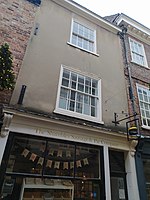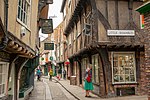9 The Shambles

9 The Shambles is an historic building in the English city of York, North Yorkshire. The two-storey timber framed building was constructed in the 15th century. Both the upper floor and the attic are jettied to The Shambles. The building might originally have been of three bays, but only two survive, and it now adjoins two roughly built bays, dating from the 16th century. The whole roof at the front also dates from this period. A brick chimney breast dates from the 17th century, with a contemporary fireplace in the attic. In the 18th century, the level of the first floor was raised, and the front was pargetted.The building was grade II* listed in 1954, and was restored from 1955 onwards. Since 2007, the shop has been the W. Hamond jewellers, which specialises in Whitby jet.
Excerpt from the Wikipedia article 9 The Shambles (License: CC BY-SA 3.0, Authors, Images).9 The Shambles
Shambles, York Bishophill
Geographical coordinates (GPS) Address Nearby Places Show on map
Geographical coordinates (GPS)
| Latitude | Longitude |
|---|---|
| N 53.959561 ° | E -1.080139 ° |
Address
Potions Cauldron
Shambles 9¾
YO1 7LZ York, Bishophill
England, United Kingdom
Open on Google Maps









